1986 | GSX-R1100
1,100 cm³ flagship and big brother of the 1985 GSX-R750
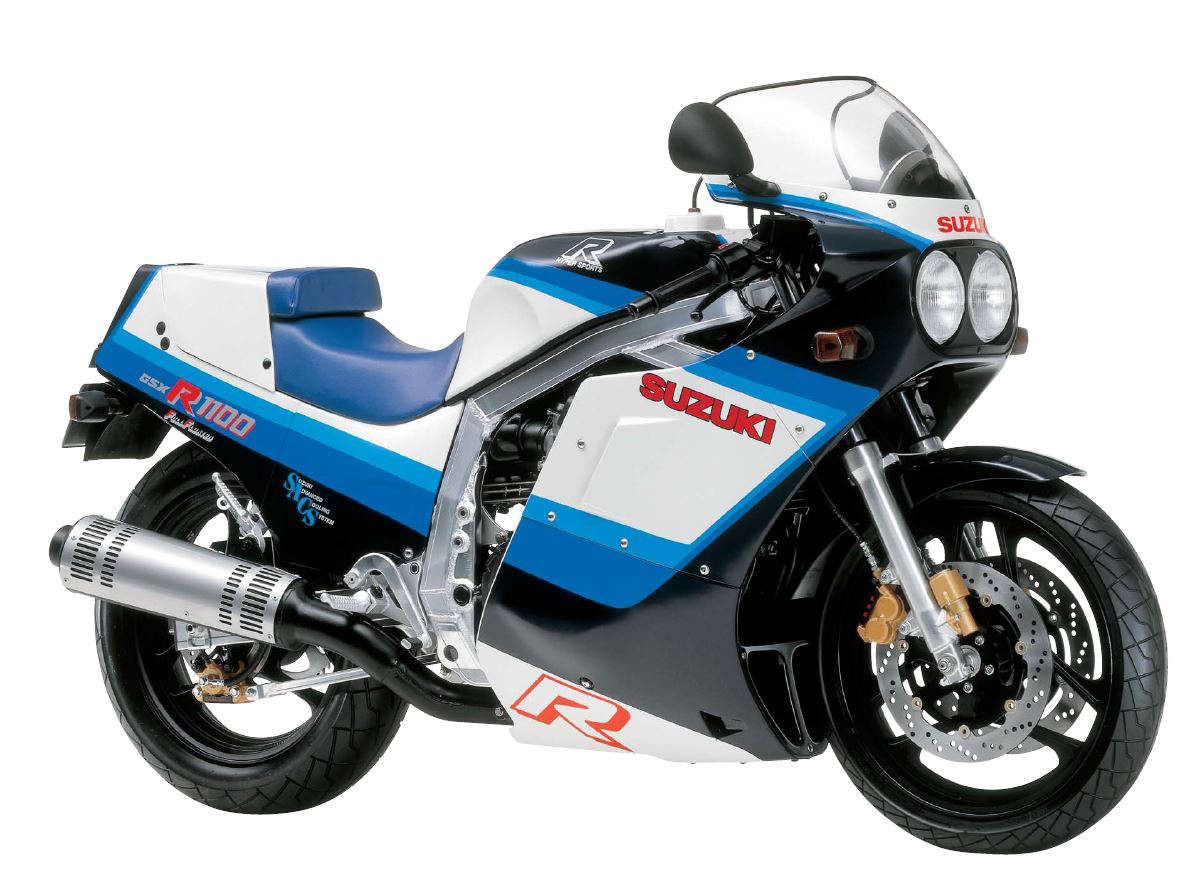
Based on the same concept as the GSX-R750 that debuted the previous year, the displacement of Suzuki’s flagship GSX-R1100 model was increased to 1,100 cm³ compared to the R750. The frame was designed based on computer analytics, which reduced its weight by around 25% from the R750 while increasing its rigidity. The 1,100 cm³ oil-cooled 4-stroke inline 4-cylinder DOHC 4-valve engine features the advanced Suzuki Advanced Cooling System (SACS), which sprays 20 liters of oil onto the cylinder heads per minute and dissipates the recovered heat via a large oil cooler. This engine generates maximum horsepower of 130 PS and is 22% lighter than a conventional air-cooled engine. As a result, the GSX-R1100 achieves a dry weight of only 197 kg and a tremendous power-to-weight ratio of 1.51. Similar to the GSX-R750, the design features horizontal dual headlights that reproduce the aggressive style of a race bike. The DNA of this GSX-R series have been passed down through successive generations to the current GSX-R1000R.
| Dimensions and weight | Dimensions | Overall length | 2,115 mm |
| Overall width | 720 mm | ||
| Overall height | 1,235 mm | ||
| Wheelbase | 1,460 mm | ||
| Weight | 197 kg (Dry) | ||
| Engine | Engine type | 4-stroke, 4-cylinder, oil-cooled, DOHC | |
| Engine displacement | 1,052 cm³ | ||
| Bore x stroke | 76.0 mm × 58.0 mm | ||
| Maximum power | 95.6kW(130PS) / 9,500rpm | ||
| Maximum torque | 101.0N-m / 8,500rpm | ||
| Transmission | 5-speed constant mesh | ||
| Front tire size | 110/80VR18 | ||
| Rear tire size | 150/70VR18 | ||
1989 | GSX-R1100
Full model change in the third year after debut featuring an upgraded engine and chassis
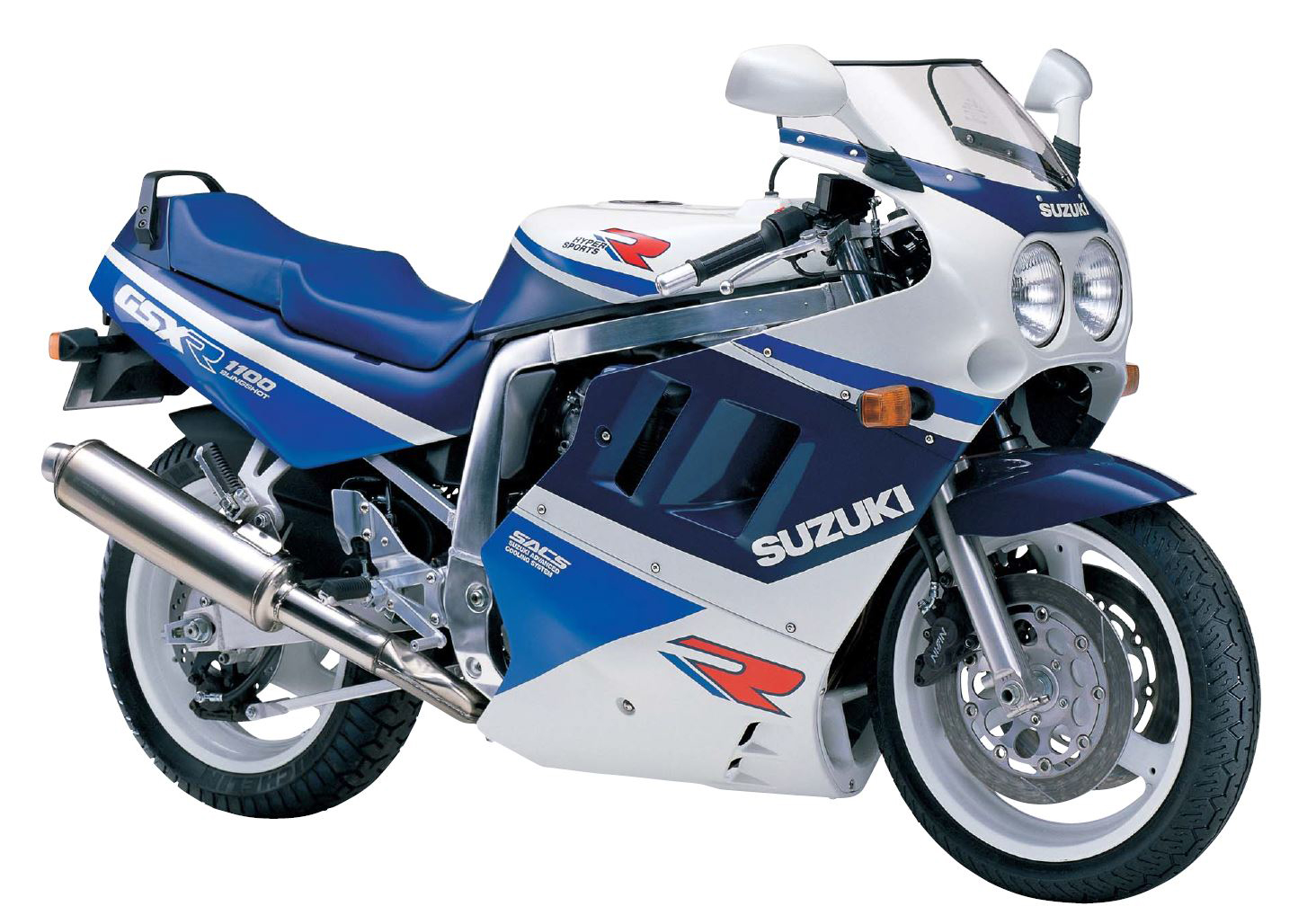
Three years after its debut in 1986, this is the first full model change of the GSX-R1100. It adopts the same styling design as the GSX-R750 full model change that was released the previous year. The bore × stroke dimensions of the oil-cooled inline 4-cylinder DOHC 4-valve engine were changed from 76 × 58 mm to 78 × 59 mm, and displacement was increased from 1052 to 1127 cm³. Maximum horsepower was raised from 130 to 143 PS by measures including an air intake in front of the fairing and dual mufflers. To handle the higher power, a new curved type oil cooler was adopted to boost cooling efficiency, and the rigidity of the frame was increased by 25% to enhance riding performance. Partially due to the two mufflers, the dry weight of this new model is 210 kg, 13 kg heavier than the first generation GSX-R1100.
| Dimensions and weight | Dimensions | Overall length | 2,050 mm |
| Overall width | 760 mm | ||
| Overall height | 1,175 mm | ||
| Wheelbase | 1,425 mm | ||
| Weight | 210 kg (Dry) | ||
| Engine | Engine type | 4-stroke, 4-cylinder, oil-cooled, DOHC | |
| Engine displacement | 1,127 cm³ | ||
| Bore x stroke | 78.0 mm × 59.0 mm | ||
| Maximum power | 101.5kW(138PS) / 9,500rpm | ||
| Maximum torque | 111.8N-m / 7,250rpm | ||
| Transmission | 5-speed constant mesh | ||
| Front tire size | 120/70ZR17 | ||
| Rear tire size | 160/60ZR17 | ||
1993 | GSX-R1100
Flagship model of the GSX-R series now equipped with a liquid-cooled engine
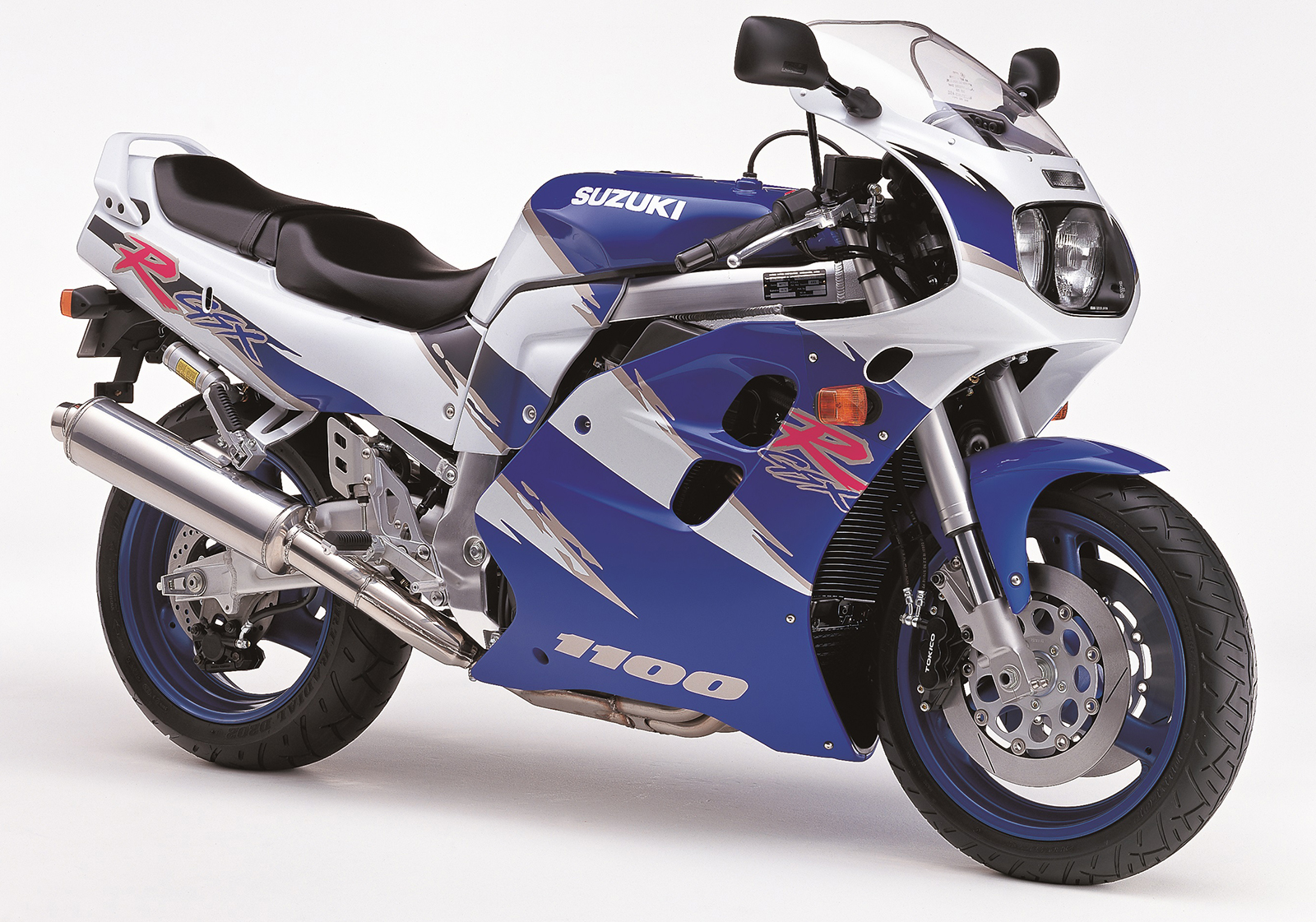
With this second full model change, a liquid-cooled engine was adopted to realize higher maximum power and sharper acceleration from low throttle opening, and to satisfy the requirement for greater cooling performance under tough environments. In addition to a large radial-flow radiator, the powerful cooling system of the GSX-R1100 also features an air-cooled oil cooler and piston oil jets. Although the new long-stroke design (bore × stroke dimensions: 75.5 × 60 mm) reduced engine displacement to 1,074 cm³, the maximum horsepower rating of 155 PS was increased by 10 PS compared to the previous model. As well as a newly designed frame with substantially higher rigidity, braking efficiency was also improved by the adoption of opposed 6-piston front brake calipers.
| Dimensions and weight | Dimensions | Overall length | 2,130 mm |
| Overall width | 755 mm | ||
| Overall height | 1,190 mm | ||
| Wheelbase | 1,485 mm | ||
| Weight | 231 kg (Dry) | ||
| Engine | Engine type | 4-stroke, 4-cylinder, liquid-cooled, DOHC | |
| Engine displacement | 1,074 cm³ | ||
| Bore x stroke | 75.5 mm × 60.0 mm | ||
| Maximum power | 114kW(155PS) / 10,000rpm | ||
| Maximum torque | 114.7N-m / 9,000rpm | ||
| Transmission | 5-speed constant mesh | ||
| Front tire size | 120/70ZR17 | ||
| Rear tire size | 180/55ZR17 | ||
2001 | GSX-R1000
Leading 1,000 cm³ supersport bike based on the 2000 GSX-R750
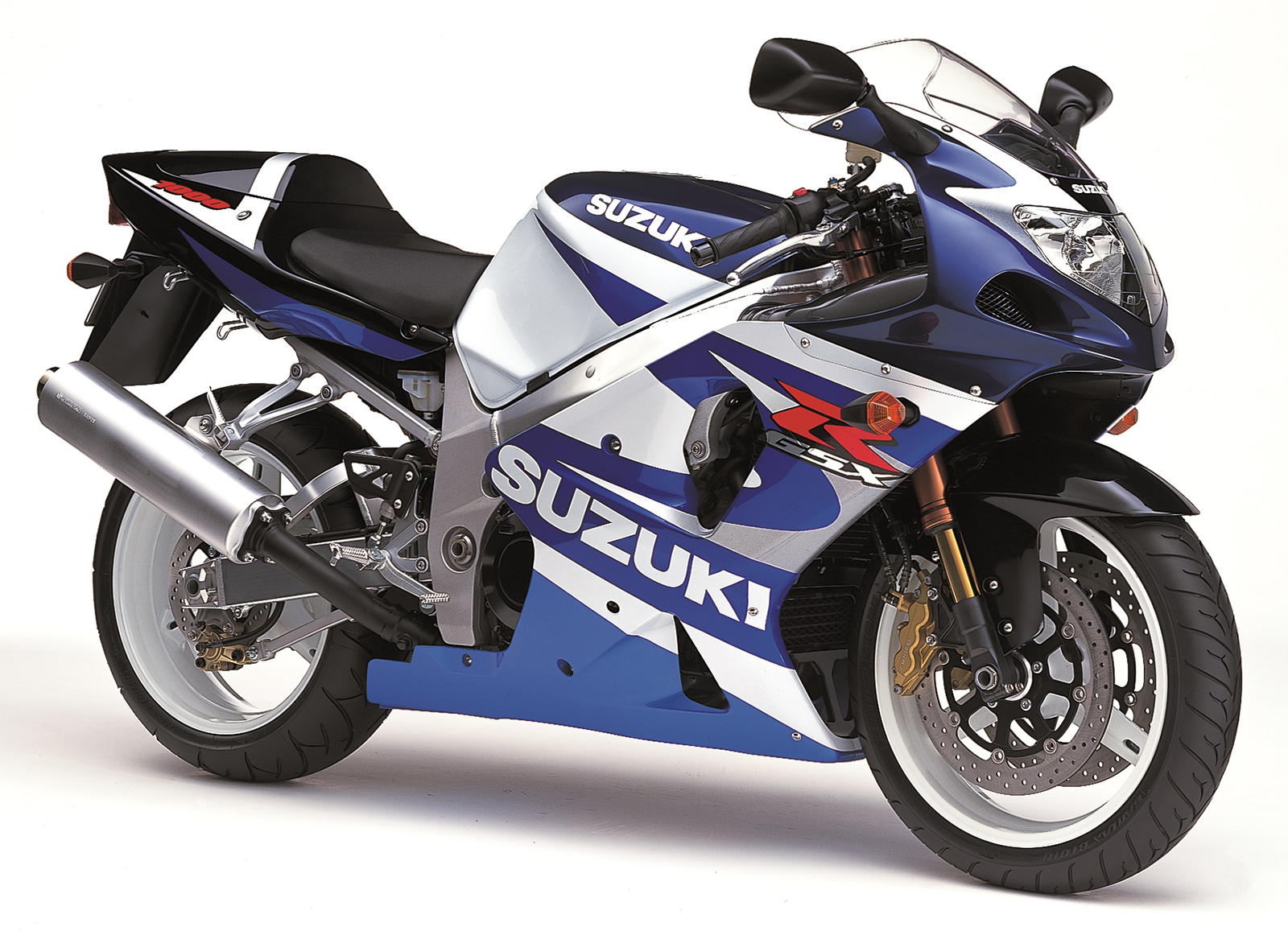
After the flagship model of the supersport class, the GSX-R1100, ended production in 1998, it was reborn in 2000 with a new engine displacement of 1,000 cm³. The GSX-R1000 is based on the GSX-R750 that debuted in 2000. The adoption of long-stroke pistons means that the size of the engine in the R1000 remains virtually unchanged from the R750 while retaining the same cylinder pitch. A lightweight and highly rigid twin spar frame was adopted in place of the double cradle frame used from the first-generation R1100. As a result, the main chassis dimensions of the R1000 are virtually the same as the R750, reflecting the thorough weight and size reduction measures applied to the engine and chassis. With a dry weight of 170 kg, the R1000 is only 4 kg heavier than the R750, and some 51 kg lighter than the 1998 R1100. The newly designed engine in the GSX-R750 also features a cutting edge fuel injection system with a stepper motor-driven secondary valve to replace the carburetor adopted in the R1100. This class-leading engine delivers high horsepower up to 160 PS while realizing excellent rideability.
| Dimensions and weight | Dimensions | Overall length | 2,045 mm |
| Overall width | 715 mm | ||
| Overall height | 1,135 mm | ||
| Wheelbase | 1,410 mm | ||
| Weight | 170 kg (Dry) | ||
| Engine | Engine type | 4-stroke, 4-cylinder, liquid-cooled, DOHC | |
| Engine displacement | 988 cm³ | ||
| Bore x stroke | 73.0 mm × 59.0 mm | ||
| Maximum power | 117.7kW(160PS) / 10,800rpm | ||
| Maximum torque | 109.8N-m / 8,500rpm | ||
| Transmission | 6-speed constant mesh | ||
| Front tire size | 120/70ZR17 | ||
| Rear tire size | 190/50ZR17 | ||
2003 | GSX-R1000
Continuously evolving top-class performer
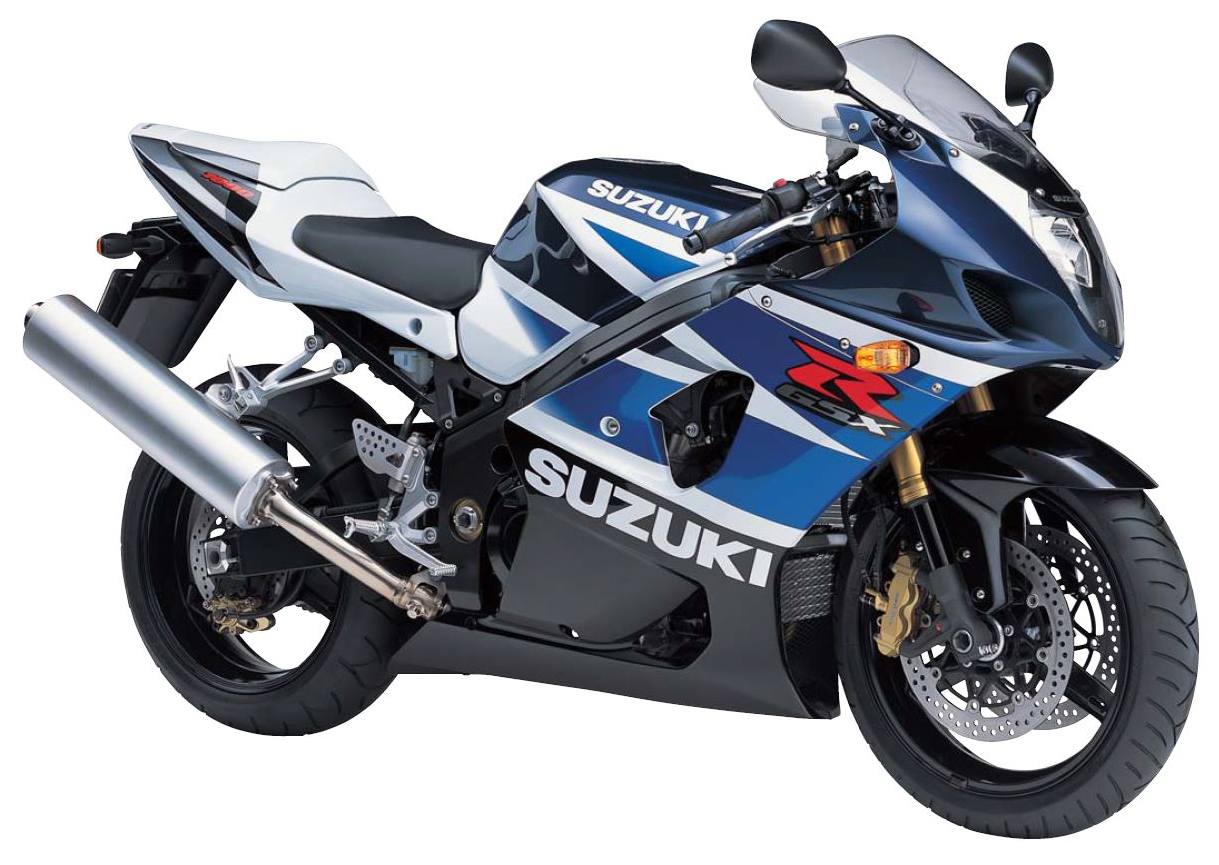
To ensure its continuous evolution, the latest iteration of the top-performing GSX-R1000 combines even higher power and lower weight with a newly designed frame and aggressively updated styling. Maximum horsepower was increased by 4 PS to 164 PS by measures such as reducing the number of throttle valve links, enhancing the fuel injection system by adopting multi-hole injectors and the like, improving the Suzuki Exhaust Tuning (SET) system, increasing the accuracy of the engine management system, and raising the efficiency of the Suzuki Ram Air Direct (SRAD) system. This new GSX-R1000 also stands out due to aggressive styling created by the adoption of vertically stacked dual headlights instead of the horizontal dual headlights of the previous model. Rigidity was increased and weight reduced by replacing the press-welded twin-beam frame side tubes of the 2002 model with extrusions incorporating central reinforcing ribs.
| Dimensions and weight | Dimensions | Overall length | 2,070 mm |
| Overall width | 715 mm | ||
| Overall height | 1,145 mm | ||
| Wheelbase | 1,410 mm | ||
| Weight | 168 kg (Dry) | ||
| Engine | Engine type | 4-stroke, 4-cylinder, liquid-cooled, DOHC | |
| Engine displacement | 988 cm³ | ||
| Bore x stroke | 73.0 mm × 59.0 mm | ||
| Maximum power | 120.6kW(164PS) / 10,800rpm | ||
| Maximum torque | 110.7N-m / 8,400rpm | ||
| Transmission | 6-speed constant mesh | ||
| Front tire size | 120/70ZR17 | ||
| Rear tire size | 190/50ZR17 | ||
2005 | GSX-R1000
Overwhelming top-class performer
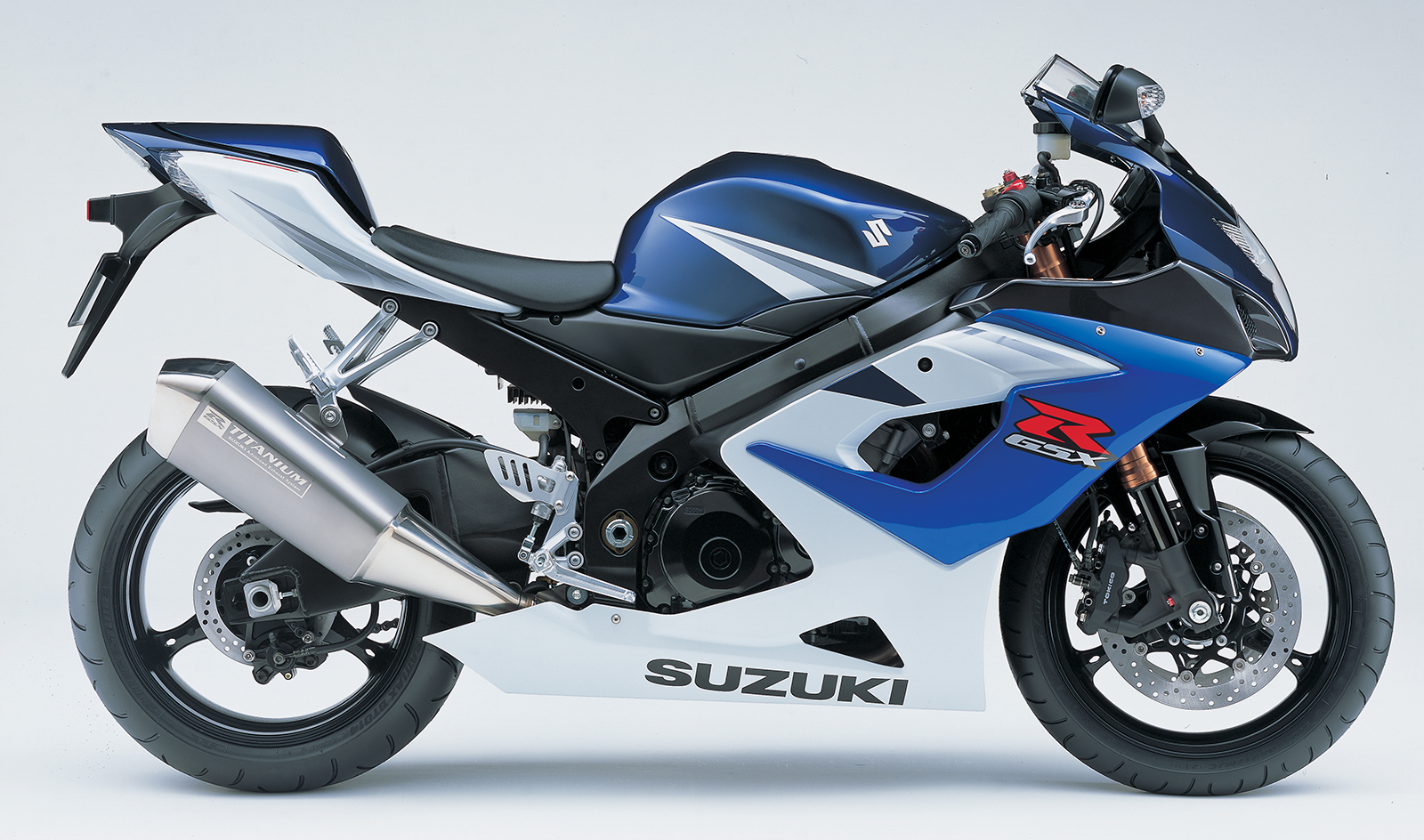
The newly designed 1,000 cm³ liquid-cooled in-line 4-cylinder DOHC 4-valve engine features 73.4 mm cylinder bores, 0.4 mm wider than the 2004 model, and a compression ratio that was raised from 12 to 12.5. The throttle body was also enlarged from 42 to 44 mm. In combination with other enhancements, such as the adoption of twin injectors, the result is a maximum horsepower of 178 PS, 8.5% higher than the 2004 model. Maximum torque was also increased by 6% to 117.6 N·m. To handle the enhanced power generated by the engine, the cooling performance of the large curved radiator was improved by 12.7%. Quicker and more stable cornering performance was realized by developing a more compact chassis. Enhancements included shortening the distance from the seat to the handlebars by around 40 mm and adopting footpegs 17 mm narrower than the previous model. Smoother deceleration was also realized through the adoption of a back-torque-limiting clutch system.
| Dimensions and weight | Dimensions | Overall length | 2,030 mm |
| Overall width | 710 mm | ||
| Overall height | 1,130 mm | ||
| Wheelbase | 1,405 mm | ||
| Weight | 166 kg (Dry) | ||
| Engine | Engine type | 4-stroke, 4-cylinder, liquid-cooled, DOHC | |
| Engine displacement | 999 cm³ | ||
| Bore x stroke | 73.4 mm × 59.0 mm | ||
| Maximum power | 131kW(178PS) / 11,000rpm | ||
| Maximum torque | 117.6N-m / 9,000rpm | ||
| Transmission | 6-speed constant mesh | ||
| Front tire size | 120/70ZR17 | ||
| Rear tire size | 190/50ZR17 | ||
2007 | GSX-R1000
Top-class performer with higher revving engine and SDMS
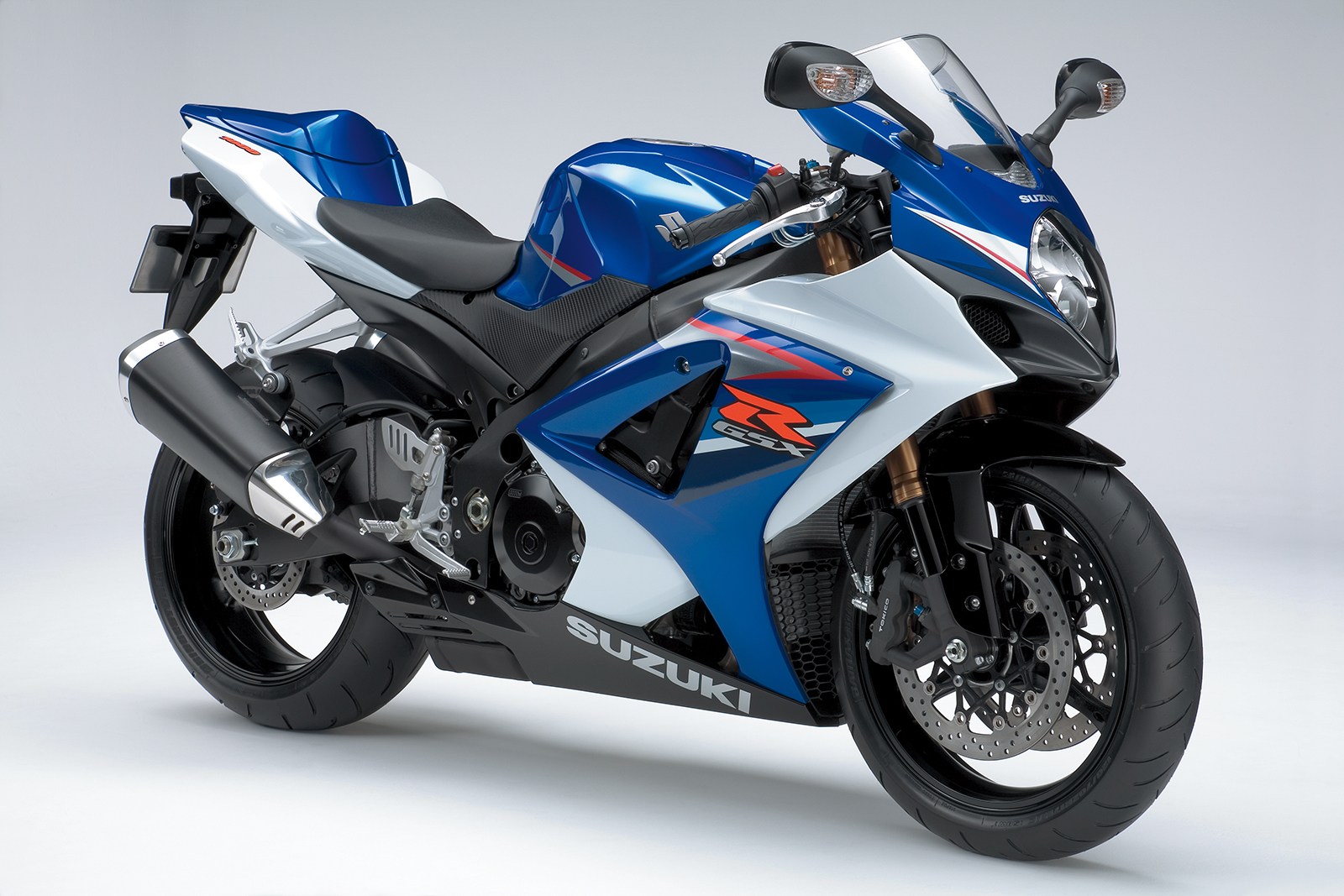
The 1,000 cm³ liquid-cooled 4-cylinder engine generates maximum horsepower of 185 PS, 3.9% higher than the 2006 model. The engine redline was also increased from 11,000 to 12,000 rpm. This was achieved by adopting twin mufflers, twin multi-hole compact injectors, and iridium spark plugs, enlarging the intake ports by 10% and the exhaust ports by 20%, and widening the ventilation holes between the cylinders. The Suzuki Drive Mode Selector (SDMS), which allows riders to select their preferred riding mode based on the conditions, was also adopted for the first time. Riding enjoyment was also enhanced by the adoption of three-way adjustable footpegs that the rider can position to enable the preferred riding style. All the components in the newly designed frame, including the head pipe as well as the left and right main beams, are castings that are welded into a rigid assembly.
| Dimensions and weight | Dimensions | Overall length | 2,045 mm |
| Overall width | 720 mm | ||
| Overall height | 1,130 mm | ||
| Wheelbase | 1,415 mm | ||
| Weight | 172 kg (Dry) | ||
| Engine | Engine type | 4-stroke, 4-cylinder, liquid-cooled, DOHC | |
| Engine displacement | 999 cm³ | ||
| Bore x stroke | 73.4 mm × 59.0 mm | ||
| Maximum power | 136kW(185PS) / 12,000rpm | ||
| Maximum torque | 116.6N-m / 10,000rpm | ||
| Transmission | 6-speed constant mesh | ||
| Front tire size | 120/70ZR17 | ||
| Rear tire size | 190/50ZR17 | ||
2009 | GSX-R1000
A 1,000 cm³ supersport bike developed under Suzuki’s fundamental “Run, Turn, and Stop” philosophy
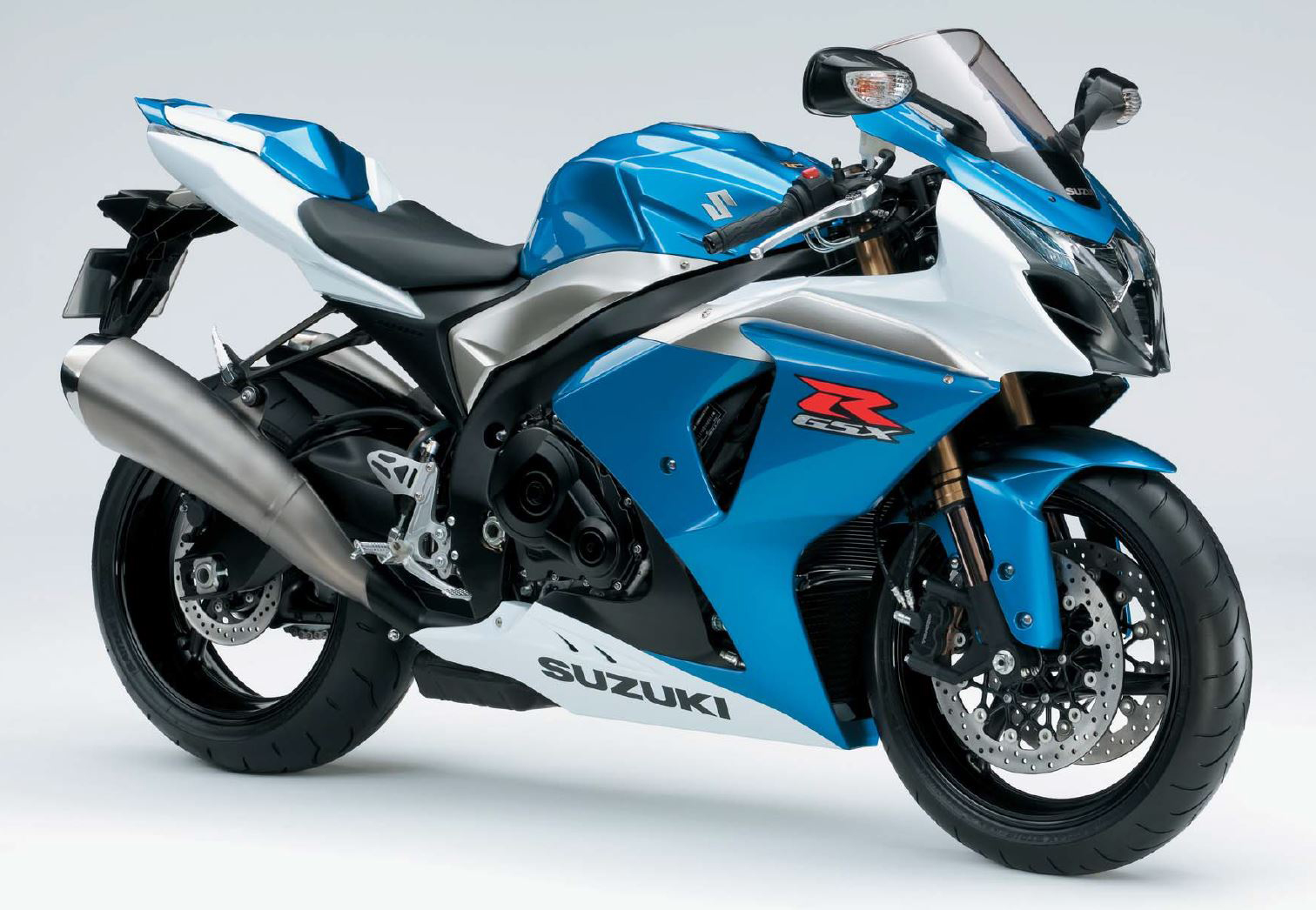
Piston speed was lowered by adopting a short stroke engine with a larger bore (the bore × stroke dimensions were revised from 73.7 × 59 mm to 74.5 × 57.3 mm), raising the potential of engine tuning to increase engine speed and power for racing. Alterations were also made to the compression ratio, cam profile, and combustion chamber shape, resulting in user-friendly flat torque characteristics in every rpm range. Although the newly designed frame sits on a 10 mm shorter wheelbase, the swingarm was lengthened by 32 mm to enhance cornering performance and traction. In addition, the welding beads were moved from the frame side surfaces to less conspicuous positions, improving the external appearance of the bike and helping to create an optimized rigidity balance. Braking performance was improved by adopting monoblock front brake calipers that reduced weight by 560 g, while increasing caliper body rigidity by 23%.
| Dimensions and weight | Dimensions | Overall length | 2,045 mm |
| Overall width | 710 mm | ||
| Overall height | 1,130 mm | ||
| Wheelbase | 1,405 mm | ||
| Weight | 203 kg (Wet) | ||
| Engine | Engine type | 4-stroke, 4-cylinder, liquid-cooled, DOHC | |
| Engine displacement | 999 cm³ | ||
| Bore x stroke | 74.5 mm × 57.3 mm | ||
| Maximum power | 136kW(185PS) / 11,500rpm | ||
| Maximum torque | 116.6N-m / 10,000rpm | ||
| Transmission | 6-speed constant mesh | ||
| Front tire size | 120/70ZR17 | ||
| Rear tire size | 190/50ZR17 | ||
2017 | GSX-R1000/R
The first Japanese spec version of “The King of Sportbikes”
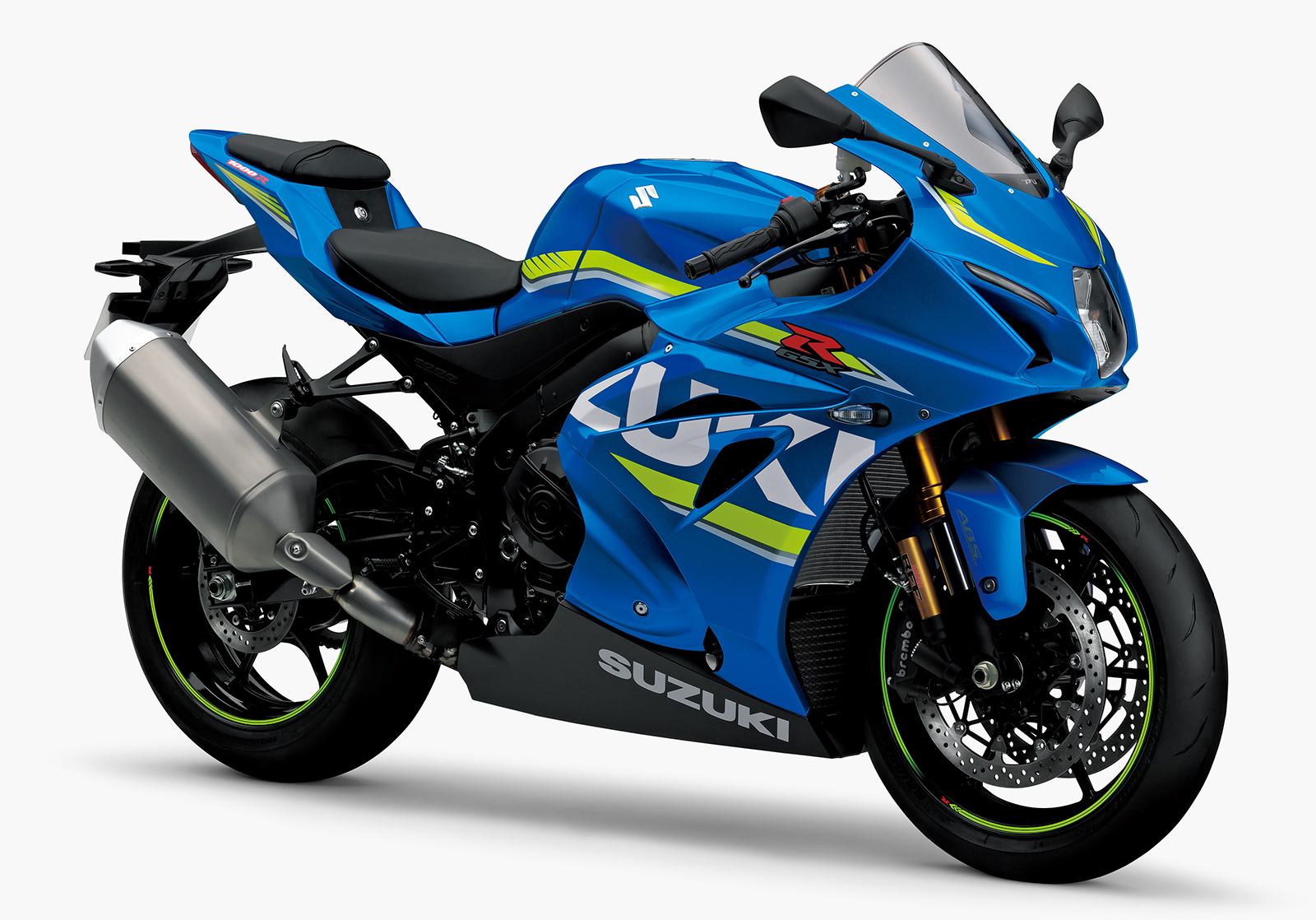
The first Japanese spec version was created for the sixth generation of the GSX-R1000, the first model change of this iconic model in eight years. Its newly developed 1,000 cm³ in-line 4-cylinder engine delivers the same maximum power of 145 kW and maximum torque of 117 N·m as the European spec model, while adopting the new Broad Power System that incorporates technologies developed for MotoGP. This system enhances the maximum power of the engine without reducing performance in the low- to mid- rpm ranges, while ensuring smooth power transfer and powerful acceleration throughout the whole rpm range. The chassis of the GSX-R1000 features a lighter frame with optimized strength. The mounting angle of the engine was adjusted to enhance cornering performance and maneuverability. The GSX-R1000 also features the Motion Tracking Brake System that stabilizes the stance of the bike during braking, the Motion Track Traction Control System that controls engine power via ten selectable levels of control intervention, and a quick shift system that helps the rider shift more smoothly.
| Dimensions and weight | Dimensions | Overall length | 2,075 mm |
| Overall width | 705 mm | ||
| Overall height | 1,145 mm | ||
| Wheelbase | 1,420 mm | ||
| Weight | 203 kg (Wet) | ||
| Engine | Engine type | 4-stroke, 4-cylinder, liquid-cooled, DOHC | |
| Engine displacement | 999 cm³ | ||
| Bore x stroke | 76.0 mm × 55.1 mm | ||
| Maximum power | 145kW(197PS) / 13,200rpm | ||
| Maximum torque | 117N-m / 10,800rpm | ||
| Transmission | 6-speed constant mesh | ||
| Front tire size | 120/70ZR17M/C (58W) | ||
| Rear tire size | 190/55ZR17M/C (75W) | ||
